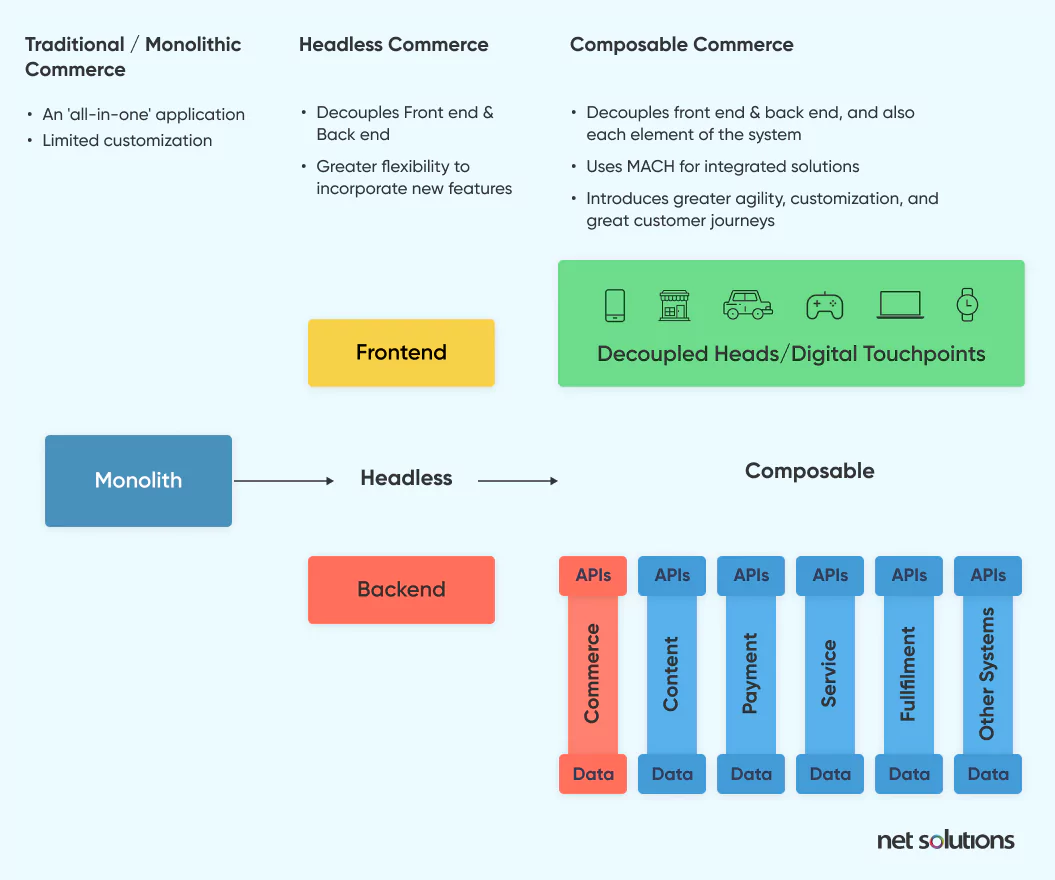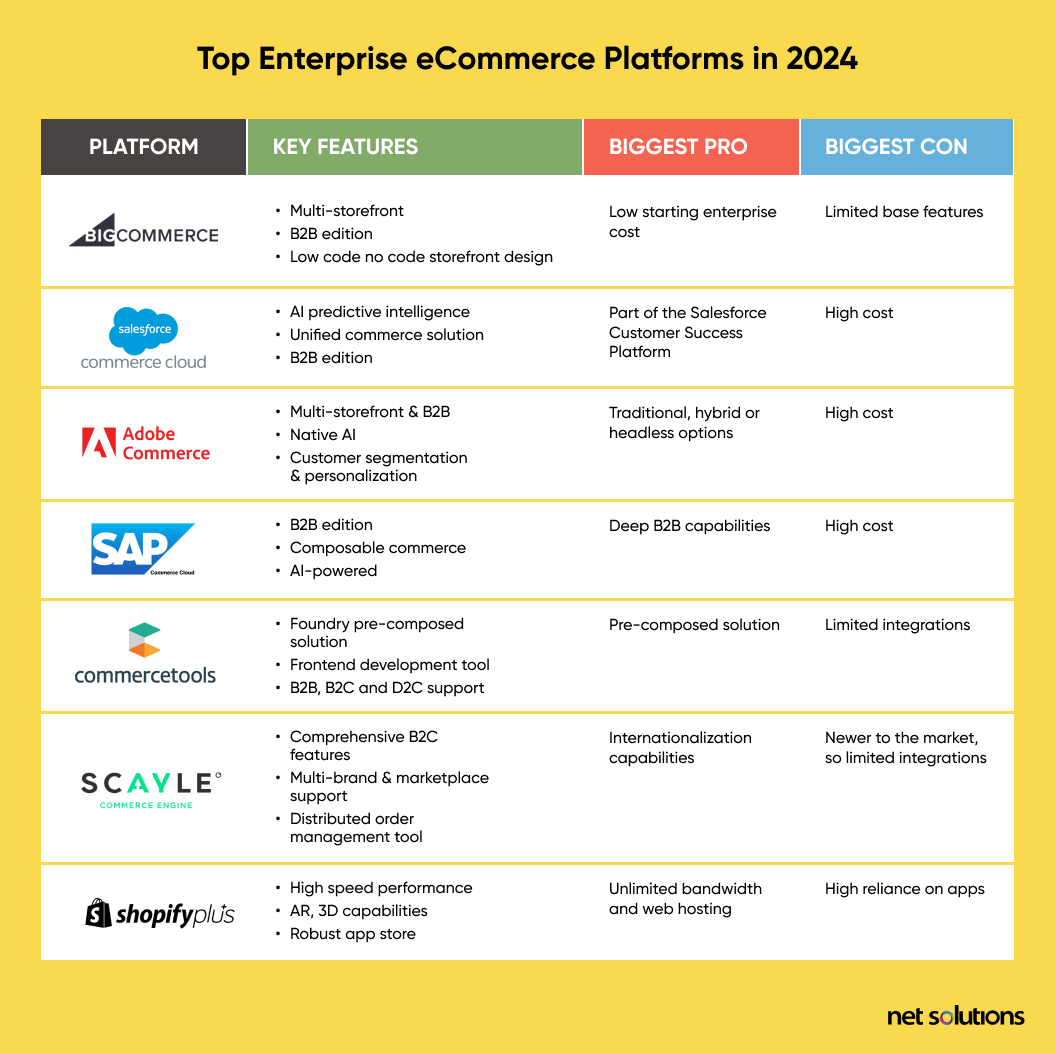Some of the best enterprise Ecommerce platforms are:
- BigCommerce
- Salesforce Commerce Cloud
- Adobe Commerce (Magento)
- SAP Hybris Commerce and Commerce Cloud
- commercetools
- SCAYLE
- Shopify Plus
Enterprises have different eCommerce needs than their small or mid-sized counterparts. Enterprises have more complex business structures and are likely to support multiple locations and varied departments who may need access to eCommerce data and/or systems. For enterprises that offer retail products and/or services internationally, this complexity extends to different locations, tax laws, shipping requirements and more.
This article will help executives and IT leaders evaluate the enterprise eCommerce landscape to discover which platform to invest in to launch a new online store or to switch to another platform (Learn more: What is replatforming?).
Disclaimer: The information below is accurate as of June 28, 2024.
Types of Enterprise eCommerce Solutions Available
eCommerce solutions are a kind of content management software (CMS) designed to help create and publish online stores to sell products or services. eCommerce solution architecture can greatly influence its capabilities, with variations that include:
Traditional eCommerce
Every kind of CMS or eCommerce solution has two parts:
- The front-end: the digital storefront people see and interact with
- The back-end: the server-side layer that holds the products, orders and customer data
A traditional or monolithic eCommerce solution tightly couples the front- and back-ends of the solution, providing an all-in-one solution that is quick to create, launch and manage. While this is great for small businesses, many enterprises find these platforms lack customizability and may not deliver on performance, scaling or omnichannel and multichannel retailing.
Headless eCommerce
Headless commerce decouples the front-end from the back-end business operations to improve scalability and personalization across channels, helping support omnichannel retailing and giving developers more freedom of choice for frontends. (Learn more about headless CMS vs traditional CMS).
Composable commerce
Composable commerce goes one step further in flexibility and performance by using microservices organized around “packaged business capabilities” or PBCs for critical functions (e.g. reviews, loyalty, service, payments) to introduce an even more granular level of customizability and agility. Composable commerce often leverages MACH architecture (M – Microservices, A – API-First, C – Cloud-Native, H – Headless).

Open Source eCommerce
When it comes to eCommerce solutions, there are both paid (licensed) and free (open source) solutions. Open-source eCommerce solutions can be downloaded and used free of charge, giving access to the source code to provide a greater level of ownership and control.
B2C vs B2C eCommerce
eCommerce platforms also support different eCommerce business models, which primarily includes capabilities for B2B and B2C eCommerce, but may also include new models such as dropshipping or subscriptions. B2B eCommerce platforms offer experiences curated to B2B customers, including capabilities for quoting, invoicing, bulk orders, order approvals, price tiers, account roles or more.
Top Enterprise eCommerce Platforms in 2025
The following enterprise eCommerce platforms have consistently ranked well in the Gartner Magic Quadrant for Digital Commerce, IDC MarketScape and Forrester Wave reports (B2C, B2B), and also reflect our own insights from working with enterprises to create curated eCommerce solutions.

1. BigCommerce
BigCommerce is a SaaS headless eCommerce platform that offers full enterprise capabilities to support omnichannel selling, B2B sales, and composable commerce.
BigCommerce Key Features
BigCommerce eCommerce functionality includes::
- User-friendly with low code no code tools for storefront design (e.g. a visual drag-and-drop editor, conversion tools)
- B2B edition with curated buying experiences in a low-maintenance platform
- Multi-storefront (regions, segments or brands) and integrated channels (marketplaces such as Amazon, eBay, Google Shopping and social media channels) all managed from one interface
BigCommerce Pros
BigCommerce is known for its ease of use, with:
- Low starting enterprise cost ($1000 base enterprise cost per month)
- Customizable with up to 95% API coverage and a large app marketplace
- PWA functionality, powering a progressive web app front-end on Vue, Next.js or Gatsby via easy integrations
BigCommerce Cons
- Limited base features, larger reliance on third-parties
- Checkout sync issues could occur between embedded checkout and headless platforms
- May not be designed for large or global enterprises (more a mid-market solution)
Learn more about Going Headless with BigCommerce.
2. Salesforce Commerce Cloud
Salesforce Commerce Cloud (previously Demandware) is a unified commerce solution, currently a top leader in the Gartner magic quadrant with an 85% recommendation rating.
Salesforce Commerce Cloud Key Features
Salesforce Commerce Cloud platform is designed for enterprises, with:
- AI predictive intelligence to create personalized customer experiences
- Unified commerce solution that integrates customer data (CRM), channels and operational functions (e.g. inventory, orders) into one platform
- B2B edition including rapid re-ordering, contract pricing, catalogs
Salesforce Commerce Cloud Pros
Salesforce Commerce Cloud is known for:
- Deeply integrated within the Salesforce Customer Success Platform to support the customer lifecycle
- Mobile-first design for all price tiers
- Robust integration tools to third-party services
Salesforce Commerce Cloud Cons
- High complexity, requiring substantial developer resources
- High learning curve for end users
- High cost
3. Adobe Commerce (Magento)
Adobe Commerce (previously Magento) is an all-in-one eCommerce PaaS solution with pre-integrated composable commerce (SaaS) services that can be deployed and adopted on the commerce foundation.
Adobe Commerce Key Features
- Adobe Commerce is a flexible, scalable and agile solution integrating leading edge capabilities in AI, omnichannel retailing, and personalization.
- Adobe Sensei GenAI uses generative AI for personalized product recommendations, live search, workflow automation assistance, and even SEO tagging
- Multi-storefront capabilities, with the ability to manage dozens or hundreds of B2C & B2B websites and marketplaces from a single interface
- Customer segmentation and personalization to dynamically display content, promotions and pricing based on factors such as location, gender, order history, wish lists or more
Adobe Commerce Pros
Adobe Commerce Pro and Adobe Commerce Managed Services, its two enterprise tiers, are known for:
- Deeply integrated with other Adobe solutions
- Scalable commerce performance with 99.99% infrastructure SLA
- Traditional, hybrid or headless options
Adobe Commerce Cons
- High yearly cost, suitable mostly for very large and/or global enterprise clients
- High degree of complexity
- Considerable development costs to manage the complexity
To learn more, read: What is Adobe Commerce (Magento) and the 11 Biggest Benefits of Adobe Commerce.
4. SAP Commerce Cloud (Hybris)
Hybris is a B2C and B2B eCommerce platform designed to support omnichannel retailing, acquired by SAP in 2013 and rebranded as SAP Commerce Cloud. SAP Commerce Cloud offers transparency over its product roadmap for new features and deep product and fulfillment capabilities.
SAP Commerce Cloud Key Features
SAP Commerce Cloud is trusted by thousands of organizations and global brands, with support for:
- B2B edition to support adaptive commerce experiences and link supply chain and demand chains with business practices. Support for B2B2C and alternative business models and tools to operate your own online marketplace.
- AI-powered for intelligent commerce (personalization, recommendations, merchandising, search)
- Composable commerce solution with microservices-based extensibility framework and industry accelerators (solutions and storefront templates)
SAP Commerce Cloud Pros
SAP Commerce Cloud is known for supporting online businesses with:
- Integrated with other SAP CRM and Customer Experience (CX) solutions
- Strong B2B capabilities
- Optimized fulfillment, sourcing and product management capabilities
SAP Commerce Cloud Cons
- High degree of complexity to install and customize
- High learning curve, particularly in areas around complex tasks or customization options. Documentation is hard to follow.
- Expensive
5. commercetools
commercetools is a composable commerce solution (MACH architecture) with “pre-composed” all-in-one capabilities for frontend, checkout and Connect to help speed up time to market.
commercetools Key Features
commercetools can be deployed quickly or with a more curated, customized implementation based on:
- commercetools Foundry, the pre-composed solution that combines best practices, services and tools such as AI-powered developer assistants to launch a store quickly
- commercetools Frontend, a frontend-as-a-service (FEaaS) solution to develop digital storefronts with PWAs or build custom frontend experiences in an intuitive development environment
- B2B, B2C and D2C support all within a single platform, including support for B2B manufacturing
commercetools Pros
commercetools offers a free trial option, allowing you to benefit from:
- Pre-composed option to accelerate time to market
- Strong documentation and customer support
- Modular approach allows you to only choose the elements you need, improving operational efficiencies
commercetools Cons
- Base platform may have some limitations for marketing and promotions and order management
- Limited SDKs and third-party integrations
- Learning curve associated with composable commerce & customizations
6. SCAYLE
SCAYLE (SCAYLE Commerce Engine) is an enterprise composable commerce platform for B2C that allows you to create a custom shop or use the Copy and Customize (built-in frontend) to accelerate time to market.
SCAYLE Key Features
SCAYLE offers a comprehensive platform that can be out-of-the-box or customized using composable commerce with:
- Comprehensive base features for promotion, checkout and customer service / support teams
- Multi-support, including multi-brand, omnichannel, internationalization, marketplaces
- Distributed order management tool to simplify multi-channel and multi-location commerce and increase transparency for consumers
SCAYLE Pros
SCAYLE is a platform that is easy to get started with, known for:
- Intuitive tools to create new customer experiences, stores, markets or brands without code
- Option to use a built-in storefront
- Strong internationalization capabilities
SCAYLE Commerce Cons
- No B2B support
- Smaller partner ecosystem
- Some features are still in their infancy
7. Shopify Plus
Shopify represents a 17.73% market share of all eCommerce platforms, with the “Shopify Plus” plan designed with high-volume enterprise customers in mind.
Shopify Plus Key Features
Shopify Plus is a headless commerce platform designed to support enterprise users over $1M in sales across online, retail and B2B with:
- High-speed performance with global dual content delivery networks (CDNs) and optimizations such as the Shopify Storefront Renderer and Shop Pay checkouts, which are 60% faster
- Integrated AR, video and 3D capabilities on product catalogs & pages
- Extensible with a robust Shopify app store to extend site features, capabilities or sales channels with a lower development cost
Shopify Plus Pros
Shopify Plus is known for being easy to use and scalable, with:
- Unlimited bandwidth and web hosting (no extra cost), 99.99% average uptime
- Simplified editor experience, among the highest user satisfaction ratings
- Extensibility through apps and APIs
Shopify Plus Cons
- Limited multi-store capabilities (capped, not all apps supported)
- Heavy use of apps, complex scripts or custom apps can increase technical debt
- Designed for smaller enterprises, without the features or capabilities to manage global brands
Enterprise eCommerce Hosting Options
When it comes to hosting options for an eCommerce website, this has to do with the choice of where a server is hosted and the level of control you’ll have over management of your site. In general, there are three options:
- PaaS hosting: Also known as “cloud hosted,” “cloud hosting”, this platform-as-a-service model provides infrastructure (e.g. servers) to set up an eCommerce site, with the client building and configuring the content, application code and products.
- SaaS hosting: Software-as-a-service bundles ready-to-use eCommerce software and the hosting together into a single service and cost, handled by one provider.
- Self-hosting: Also known as “on-premise,” this model involves using an open-source or licensed eCommerce solution that is hosted and managed by the client (which could be in the cloud with IaaS).
Learn more: IaaS vs PaaS vs SaaS: Which Cloud Strategy is Right for Your Business?
Key Features to Look for in an Enterprise eCommerce Platform
When it comes to choosing an eCommerce platform that can handle the complex needs of your business at scale, consider:
- Strong core capabilities: Every eCommerce vendor will have a different idea about what capabilities should be “core” and what should be relegated to third-party integrations or plugins. Enterprises should consider choosing a platform with strong core capabilities that reduce the reliance on third-party solutions for standard capabilities (e.g. checkout, payments) and capabilities in perhaps non-core areas (e.g. inventory management) that are business critical.
- Regular updates: Seek a solution that is regularly updated for security, performance, and core capabilities, as well as through integrations or deeper partnership opportunities.
- Business model support: Choose a platform that has strong capabilities to support your business model(s), whether that’s B2C, B2B, Dropshipping, custom marketplaces or more.
- Usability: In an enterprise environment, you likely have multiple teams working in the platform across sales, marketing and customer service. Choose a platform that is intuitive to use, with the features you require such as no-code user experience tools.
- Extensibility: Look for a platform that has strong API connections, third-party integrations, frontend SDKs, developer tools and easy-to-follow documentation
- Headless or composable commerce: For larger enterprises, consider future-proofing your investment with headless or composable commerce, allowing more flexibility and agility to changing demands and opportunities.
Once you have some parameters in mind, you can then compare each shortlisted platform following our guidelines below.
How to Choose the Best Enterprise eCommerce Platform
If you are planning to start and scale your eCommerce business quickly, or are looking for a new enterprise eCommerce platform to meet your current demands, here are some tips on how to make the right choice:
1. Business goals
Whether this is a new initiative or one of application modernization, it’s important to start by understanding the business needs and the goals or objectives of the project and/or understand what the current challenges are that are driving a replatforming effort. (Learn more: what is replatforming?)
2. Evaluate platforms
Consider the leading cloud-based eCommerce platforms in the market, looking to research reports and guides such as this one, evaluating per the criteria established above as well as other factors that impact your business (e.g. performance goals, security, compliance). Read reviews and pursue demos to gain a greater understanding.
3. Cost analysis
Understand the cost of ownership associated with the enterprise-level eCommerce platform, including monthly or yearly licensing costs, costs of integrations, cost of design or development, replatforming costs (data migration), ongoing maintenance. See below for an in-depth analysis of costs.
4. Determine architecture
Evaluate which architecture is right to meet your long and short-term goals (traditional, headless, composable) and support business processes.
5. Establish technical expertise
Determine if you have the technical expertise necessary to set up or replatform your eCommerce store. If not, choose an easier platform or consider outsourcing for Custom Ecommerce Development Services.
To further establish the budget for your enterprise-level eCommerce store, let’s examine the costs.
6. Enterprise eCommerce Platform Costs
The true Costs of Launching a Custom eCommerce Website for an enterprise range significantly, from tens of thousands of dollars to hundreds of thousands of dollars.
7. eCommerce platform cost
The platform itself will have monthly or annual licensing fees, unless it is an open-source solution. In all cases, it is prudent to speak to platform sales to get a custom quote (RFP) that establishes any limits, added fees or overages that may not be obvious in the price.
8. Development and integration costs
The more customization you want, or the more ‘open’ the platform (headless, composable), the higher the development costs. Development costs will have to consider any custom frontends that need to be developed, integrations (third-party or custom), customization options, and legacy system integrations to support eCommerce operations. These costs may include both inhouse and outsource costs, which can be leveraged to streamline development.
9. Website design costs
As with development, design costs should be factored and include any custom features and usability testing designed to optimize the User Experience (UX).
10. Migration costs
For eCommerce replatforming projects, this will also include significant time to migrate data from one platform to another. This cost can include developers, UX, business analysts, solution architects, testing and other key stakeholders. The time for this could be weeks to months. For non-replatforming costs, migration will still include getting critical data out of existing systems (customer relationship management / CRM, ERP, etc) to create a new system of truth.
11. Maintenance costs
The platform you choose will influence your level of maintenance in everything from eCommerce operations and security features to servers, storage, networking, and ongoing upgrades. This comes down to your core decisions for open-source or on-premise, PaaS or SaaS platform as well as architecture (traditional, headless, composable).
With these factors now summarized, it’s time for next steps.
The Bottom Line
The choice in enterprise eCommerce software can be a huge factor in supporting the profitability and growth of your business. We hope this guide has helped you evaluate some of the top eCommerce platforms available on the market.
With over two decades of experience working with enterprises to build, launch and operate B2C and B2B eCommerce solutions, our team at Net Solutions knows how to use eCommerce platforms and third-party apps to their fullest to help get your projects off on the right foot. If you’re ready to get started on your project, learn more about our reputation in the world of Custom Ecommerce Development Services.



